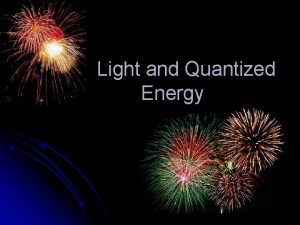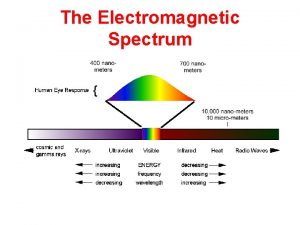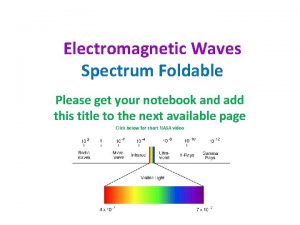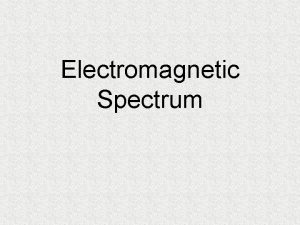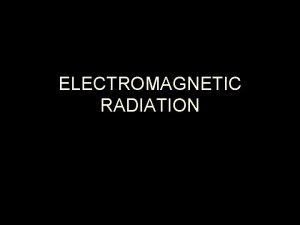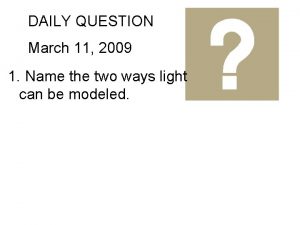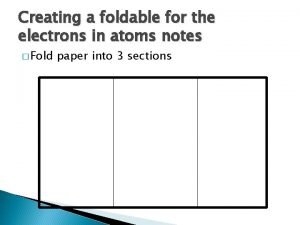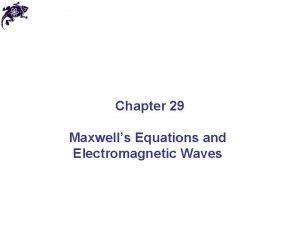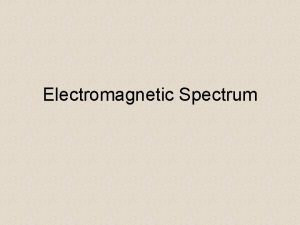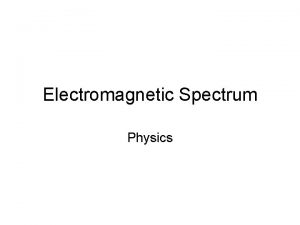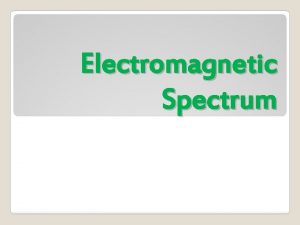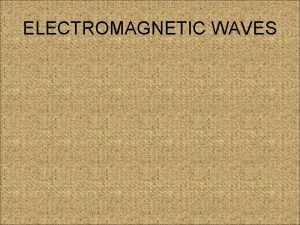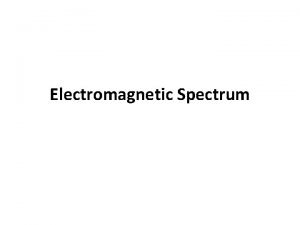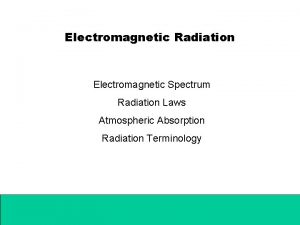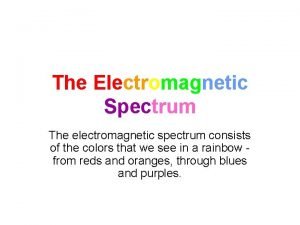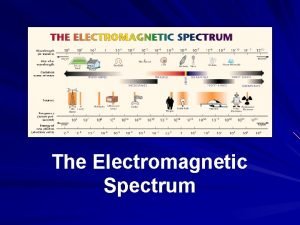Electromagnetic Spectrum Electromagnetic Radiation Electromagnetic radiation a form












- Slides: 12

Electromagnetic Spectrum

Electromagnetic Radiation • Electromagnetic radiation – a form of energy that exhibits wavelike behavior as it travels through space • Visible light • Microwaves • X-rays • Radio waves

Waves • Wavelength (λ) – shortest distance between equivalent points in a continuous wave • m, cm, nm • Frequency (ν) – number of waves that pass a given point per second • 1/s = Hz = s-1 • Amplitude – wave’s height from the origin to a crest or trough • All waves travel at the speed of light in a vacuum (2. 998 x 108 m/s)


Electromagnetic Spectrum • Electromagnetic spectrum – contains all forms of electromagnetic radiation – shows differences in frequencies and wavelengths

Electromagnetic Spectrum

Wave Calculations • c=λν • C = speed of light (2. 998 x 108 m/s) • λ = wavelength (m) • ν = frequency (Hz; 1/s)

Wave Calculations • Microwaves are used to cook food and transmit information. What is the wavelength of a microwave that has a frequency of 3. 44 x 109 Hz? • Given: • ν = 3. 44 x 109 Hz • c = 2. 998 x 108 m/s Find: λ (=x) • c=λν • 2. 998 x 108 m/s = (x) (3. 44 x 109 Hz) • X = 8. 72 x 10 -2 m

Energy • As electrons absorb energy, they move to higher energy orbits • Excited state electron configuration • 2 s �� 2 p • They will naturally fall back down to their ground state and release the energy gained as a photon of light • Ground state electron configuration • 2 p �� 2 s

Ground State vs Excited State

Energy Calculations • E=hν • E = energy absorbed/emitted • h = Planck’s constant: 6. 626 x 10 -34 J∙sec • ν = frequency (Hz; 1/s) • Remember: c = λ ν • So E = h c λ

Energy Calculations • An electron is excited to the 3 s sublevel from the 2 s sublevel. As the electron falls back down to its ground state, it releases yellow light with a wavelength of 585 nm. What amount of energy did the photon contain? • • Given: λ = 585 nm h = 6. 626 x 10 -34 J∙sec c = 2. 998 x 108 m/s Find: E • E=hc λ • E = (6. 626 x 10 -34 J∙sec) (2. 998 x 108 m/s) 5. 85 x 10 -7 m = 3. 40 x 10 -19 J
 Types of radiation in the electromagnetic spectrum
Types of radiation in the electromagnetic spectrum Electromagnetic radiation
Electromagnetic radiation Explain electronic configuration of cu and cr
Explain electronic configuration of cu and cr Absorption spectrum
Absorption spectrum What is the shortest electromagnetic wavelength
What is the shortest electromagnetic wavelength Edwin hubble
Edwin hubble Starting to wavelength lyrics
Starting to wavelength lyrics Electromagnetic spectrum foldable
Electromagnetic spectrum foldable Characteristics of ultraviolet rays
Characteristics of ultraviolet rays Electromagnetic spectrum micrometers
Electromagnetic spectrum micrometers Electromagnetic spectrum mnemonic
Electromagnetic spectrum mnemonic Electromagnetic spectrum foldable
Electromagnetic spectrum foldable теория максвелла
теория максвелла
